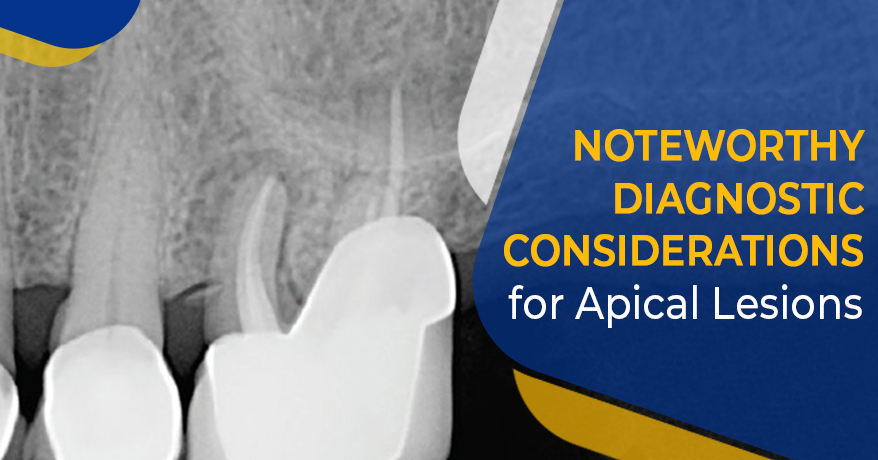Menu

The study titled ‘Apical Lesions: Diagnostic Considerations’ was originally published by Dentistry Today.
“My X-ray report showed a dark spot” is a statement often heard from patients in the endodontic office. What the patient means is that there is a possible abscess or some form of periradicular radiolucency (PRRL). In such cases, the practitioner must answer the following diagnostic questions to offer the best treatment:
This article aims to answer the above questions by providing four case studies that highlight some diagnostic possibilities for various PRRLs.
Case 1: Anatomic Structures
PRRLs are always not indicative of pathology that requires endodontic therapy. It is important to carry out pulp vitality tests to avoid misdirected and unnecessary treatment. Resulting from tooth necrosis, a few common anatomic structures could be mistaken for apical lesions. These usually include the nasal floor, mental foramen near lower premolars, and the incisive canal.
A 51-year-old woman needed an evaluation of tooth number 20. Even though the patient was asymptomatic, her dentist was concerned about an abscess associated with the tooth. A cold stimulus vitality testing showed a normal response in tooth number 20. The tooth displayed normal pulp and the PRRL was the mental foramen. When facing a doubt, test the teeth vitality in the area. Note that endodontic therapy is not required for all PRRLs.
Case 2: Oral Pathology
Moving along with the concept that endodontic intervention is not required for all PRRLs, different non-odontogenic entities produce variations on radiograph mimicking lesions that are of endodontic origin.
The patient is a 56-year-old woman who was placed on antibiotics due to multiple abscesses. She was told by her referring dentist that she needed many root canals. The patient was also asymptomatic and numerous areas of possible concern were noticed after a periapical radiograph was conducted on the lower anterior teeth.
Are multiple abscesses present and are these necrotic teeth? The answer lies in carrying out proper pulp tests. Through thermal testing with a cold stimulant, a positive/normal response was produced. A positive response was also shown by the electric pulp tester. The patient was asymptomatic and the gingival tissues were normal in texture and color. These teeth weren’t abscessed and were normal and vital. There was no need for endodontic therapy. With a clear line of pulp, it is possible to avoid antibiotics and avoid endodontic therapy altogether.
Multiple malignant or benign tumors could present as PRRLs. Few possibilities include ameloblastoma lesions, metastatic lesions, Keratocystic odontogenic tumors, and central giant cell lesions. An oral pathology should always be considered when there are any diagnostic concerns.
Case 3: Vertical Root Fractures
A vertical root fracture (VRF) with previous endodontic therapy could cause the presence of a PRRL. This kind of lesion usually displays a J-shaped pattern on the periapical radiograph and will be in conjunction with a deep, isolated periodontal probing depth
The patient is a 61-year-old female. Endodontic therapy was performed on tooth number 14, several years back. The patient had trouble while chewing and was experiencing pain. A periapical radiograph revealed a J-shaped lesion from the apex of the mesiobuccal root, coronally. Periodontal probing depths were under normal ranges, but the buccal side of the mesiobuccal root was not. The probe sank to the apex at this point and a diagnosis of VRF was determined.
In endodontic diagnosis, cone beam computed tomography (CBCT) has recently been used. One big misconception regarding this technology is its ability to easily detect VRFs. To visualize VRF, it must be big enough and within the CBCT scanner resolution. This is not always the case and it is not possible to easily notice a VRF.
An indirect method to detect a VRF by CBCT is by interpreting the surrounding radiographic changes in the bone pattern. Even though CBCT is limited in its ability to notice VRFs, the use of CBCT in the endodontic evaluation of PRRLs should be continued. The reason being, a CBCT scan can identify a lesion that may not be visible on a periapical radiograph.
Case 4: Missed Canals
A 62-year-old man was experiencing pain in the upper left quadrant and tooth number 15 has become tender to percussion and chewing. Endodontic therapy was performed on tooth number 15 several years ago. A periapical radiograph failed to reveal any obvious lesions. CBCT scan revealed a clear radiolucency at the apex of the mesiobuccal root. Retreatment was carried out for tooth number 15 and an untreated second canal was discovered in the mesiobuccal root. With this case, we can understand the value of CBCT in detecting lesions that are hard to identify with radiographic techniques.
Conclusion:
If a patient displays dark spots on the radiograph, it is best to consider the different possibilities of its etiology. All PRRLs are usually not caused because of pulp necrosis. Anatomic structures, VRF fractures, oral pathology, and radiographic techniques can present themselves like an abscess.
It is also important to know that endodontic therapy is not the solution to all periradicular radiolucencies. The key to an effective and successful diagnosis in endodontics is based on assessing pulp vitality. If a tooth is asymptomatic and vital, think twice before going ahead with endodontic treatment.
Source:
https://www.dentistrytoday.com/articles/10583


| PRODUCTS | QTY | PRICE | VALUE in INR |
|---|
| PRODUCTS | QTY | PRICE | VALUE in INR |
|---|